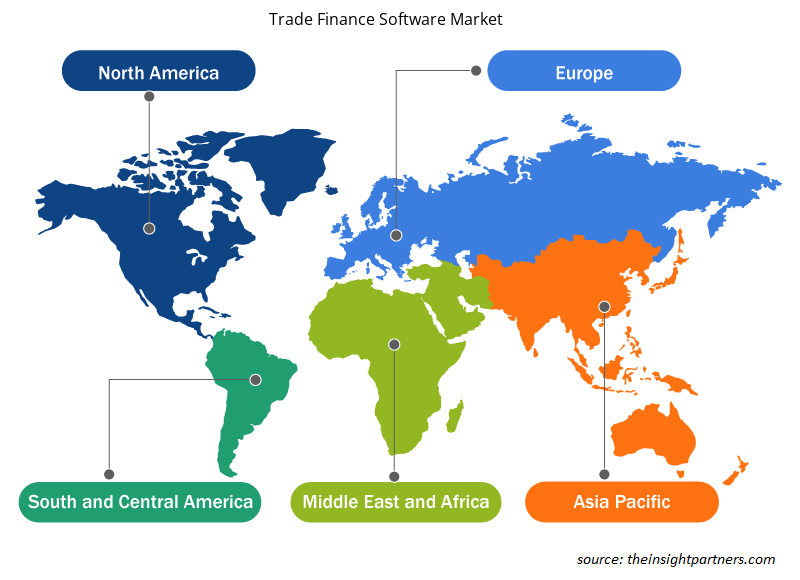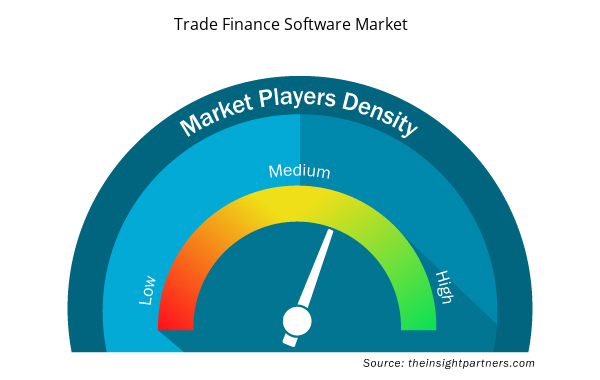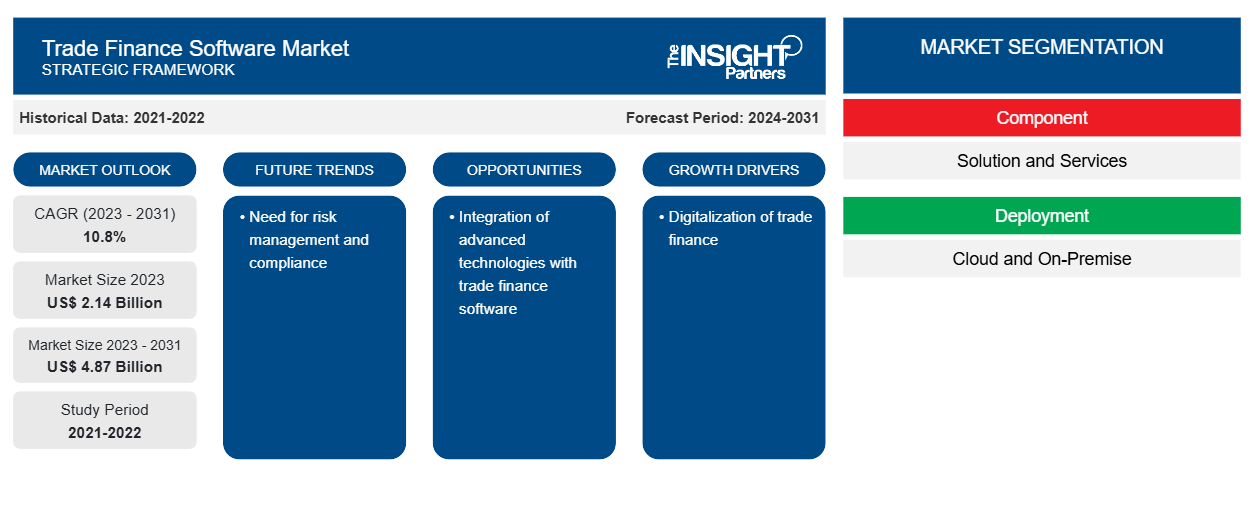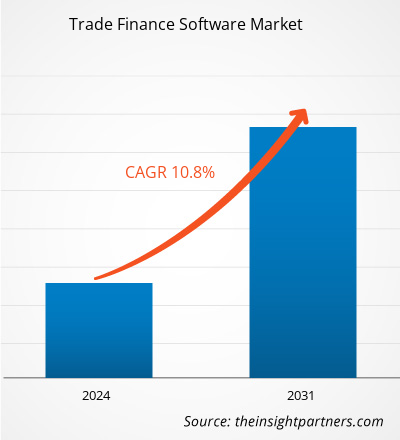貿易金融ソフトウェア市場の規模は、2023 年の 21 億 4,000 万米ドルから 2031 年には 48 億 7,000 万米ドルに達すると予測されています。市場は 2023 年から 2031 年にかけて 10.8% の CAGR を記録すると予想されています。デジタル化の進展とクラウドベースのテクノロジーの採用は、今後も貿易金融ソフトウェア市場の主要なトレンドであり続けると思われます。
貿易金融ソフトウェア市場分析
貿易金融プロセスのデジタル化が進むことは、貿易金融ソフトウェア市場の成長を後押しする大きな要因です。効率性の向上とコストの削減により、電子文書とクラウドベースの貿易金融ソリューションが従来の紙ベースの方法に取って代わるようになり、市場の成長に貢献しています。
貿易金融ソフトウェア市場の概要
透明性と国際貿易規制の遵守の必要性から、リアルタイムの監視およびレポート機能を備えたソフトウェア ソリューションの採用が促進されています。国際貿易の変化するニーズを満たす最先端のソリューションを提供することに重点を置く貿易金融ソフトウェア市場は、世界の貿易環境が変化し続け、企業がより安全で効率的な貿易金融業務を求める中、さらなる拡大が見込まれています。
要件に合わせてレポートをカスタマイズする
このレポートの一部、国レベルの分析、Excelデータパックなど、あらゆるレポートを無料でカスタマイズできます。また、スタートアップや大学向けのお得なオファーや割引もご利用いただけます。
- このレポートの主要な市場動向を入手してください。この無料サンプルには、市場動向から見積もりや予測に至るまでのデータ分析が含まれます。
貿易金融ソフトウェア市場の推進要因と機会
貿易金融のデジタル化が市場に有利に
さまざまな業界の企業が、国際貿易業務を迅速化し、改善するために最先端のソリューションが必要であることを認識するにつれて、市場は大幅に拡大しています。この市場には、サプライチェーンファイナンス、コンプライアンス管理、請求書ファクタリング、クレジット管理などの貿易金融手順を改善および自動化するために作成されたソフトウェアプログラムが含まれます。組織は、貿易取引の複雑さと量の増加の結果として、手作業と時間のかかるタスクを削減し、精度を向上させ、国際貿易に関連するリスクを最小限に抑えるために貿易金融ソフトウェアに目を向けており、これがさらに市場プレーヤーによる貿易金融ソフトウェアの採用につながっています。たとえば、2023年11月、金融ソフトウェアアプリケーションとマーケットプレイスの世界的なプロバイダーであるFinastraは、国際コーポレートバンクであるCQUR BankがFinastraと提携してテクノロジー戦略を実行したことを発表しました。Finastraの市場をリードするソリューションであるTrade InnovationとCorporate Channelsを実装することで、CQUR Bankは企業顧客にシームレスなユーザーエクスペリエンスを提供する新しいオンラインバンキングポータルを提供し、新しいデジタルワークフローを導入し、ホスト間統合ソリューションを提供します。
リスク管理とコンプライアンスの必要性
リスク管理とコンプライアンスの向上に対するニーズの高まりも、貿易金融ソフトウェア市場の成長を後押しする要因の 1 つです。貿易金融ソフトウェアは、国際貿易に関連するリスクを追跡および軽減するための、詐欺検出、マネーロンダリング防止(AML) チェック、貿易法および制裁への準拠など、高度なツールを提供します。企業や金融機関が法律や規制のコンプライアンスを維持しながら国際貿易の課題に対処しようとしているため、これらのソフトウェア ソリューションのニーズは高まり続けています。
貿易金融ソフトウェア市場レポートのセグメンテーション分析
貿易金融ソフトウェア市場分析の導出に貢献した主要なセグメントは、コンポーネント、展開、企業規模、および最終用途です。
- コンポーネントに基づいて、市場はソリューションとサービスに分割されています。ソリューションセグメントは2023年に大きな市場シェアを占めました。
- 展開別に見ると、市場はクラウドとオンプレミスに分かれています。2023年にはクラウドセグメントがより大きな市場シェアを占めました。
- 企業規模別に見ると、市場は大企業と中小企業に分かれています。中小企業セグメントは最も高い CAGR で成長すると予想されています。
- 最終用途別に見ると、市場は銀行、トレーダー、その他に分類されます。銀行セグメントは2023年に大きな市場シェアを占めました。
貿易金融ソフトウェアの地域別市場シェア分析
貿易金融ソフトウェア市場レポートの地理的範囲は、主に北米、アジア太平洋、ヨーロッパ、中東およびアフリカ、南米/中南米の 5 つの地域に分かれています。
収益面では、北米は2023年に最大の貿易金融ソフトウェア市場シェアを占めました。北米は技術ソリューションを早期に導入しており、それが市場シェアの急上昇につながっています。中小企業によるクラウドベースの技術の採用は市場の成長につながります。銀行のデジタル化の急速な進展により、貿易金融ソフトウェアの需要がさらに高まり、北米の貿易金融市場シェアを押し上げています。
貿易金融ソフトウェア市場の地域別洞察
予測期間を通じて貿易金融ソフトウェア市場に影響を与える地域的な傾向と要因は、Insight Partners のアナリストによって徹底的に説明されています。このセクションでは、北米、ヨーロッパ、アジア太平洋、中東およびアフリカ、南米および中米にわたる貿易金融ソフトウェア市場のセグメントと地理についても説明します。

- 貿易金融ソフトウェア市場の地域別データを入手
貿易金融ソフトウェア市場レポートの範囲
| レポート属性 | 詳細 |
|---|---|
| 2023年の市場規模 | 21億4千万米ドル |
| 2031年までの市場規模 | 48億7千万米ドル |
| 世界のCAGR(2023年~2031年) | 10.8% |
| 履歴データ | 2021-2022 |
| 予測期間 | 2024-2031 |
| 対象セグメント | コンポーネント別
|
| 対象地域と国 | 北米
|
| 市場リーダーと主要企業プロフィール |
|
貿易金融ソフトウェア市場のプレーヤー密度:ビジネスダイナミクスへの影響を理解する
貿易金融ソフトウェア市場は、消費者の嗜好の変化、技術の進歩、製品の利点に対する認識の高まりなどの要因により、エンドユーザーの需要が高まり、急速に成長しています。需要が高まるにつれて、企業は提供内容を拡大し、消費者のニーズを満たすために革新し、新たなトレンドを活用し、市場の成長をさらに促進しています。
市場プレーヤー密度とは、特定の市場または業界内で活動している企業または会社の分布を指します。これは、特定の市場スペースに、その市場規模または総市場価値に対してどれだけの競合相手 (市場プレーヤー) が存在するかを示します。
貿易金融ソフトウェア市場で事業を展開している主要企業は次のとおりです。
- CGI株式会社
- コマーチSA
- IBSFINテック
- ICSファイナンシャルシステムズ株式会社
- MITech - Make Intuitive Tech SA
- ニュージェン ソフトウェア テクノロジーズ株式会社
免責事項:上記の企業は、特定の順序でランク付けされていません。

- 貿易金融ソフトウェア市場のトップキープレーヤーの概要を入手
貿易金融ソフトウェア市場のニュースと最近の動向
貿易金融ソフトウェア市場は、重要な企業出版物、協会データ、データベースを含む一次および二次調査後の定性的および定量的データを収集することによって評価されます。以下は、市場の動向の一覧です。
- 2022 年 9 月、デジタル トランスフォーメーション製品の世界的大手プロバイダーである Newgen Software は、ムンバイでの顧客ミーティングで世界初のローコード トレード ファイナンス プラットフォームを発表しました。トレード ファイナンスは、大量の書類、複数の利害関係者、コンプライアンス要件を伴う複雑なプロセスです。Newgen の包括的で構成可能で将来を見据えたトレード ファイナンス プラットフォームは、銀行がペーパーレス化を進め、エンドツーエンドのトレード プロセスを合理化すると同時に、国内および国際規制へのコンプライアンスを確保するのに役立ちます。(出典: CXOtoday、プレス リリース、2022 年)
- 2024 年 2 月、金融ソフトウェア アプリケーションおよびマーケットプレイスの世界的プロバイダーである Finastra と、世界的なデジタル変革コンサルティングおよびインテグレーターである Tesselate は、貿易金融のデジタル化をより迅速かつ容易にする、エンドツーエンドのパッケージ化されたサービスを開始すると発表しました。Finastra Trade Innovation および Corporate Channels を搭載した Tegula Trade Finance as a Service により、米国の銀行は手動プロセスを自動化し、市場投入までの時間と価値を短縮して新しい需要に適応できます。Finastra の FusionFabric.cloud を介して、銀行は人工知能、ブロックチェーン、自動化ツールなどの最新技術を使用するフィンテック アプリケーションをシームレスに統合することもできます。(出典: Finastra、プレスリリース、2024 年)
貿易金融ソフトウェア市場レポートの対象範囲と成果物
「貿易金融ソフトウェア市場の規模と予測(2021〜2031年)」レポートでは、以下の分野をカバーする市場の詳細な分析を提供しています。
- 対象範囲に含まれるすべての主要市場セグメントの世界、地域、国レベルでの市場規模と予測
- 市場の動向(推進要因、制約、主要な機会など)
- 今後の主な動向
- 詳細なPEST/ポーターの5つの力とSWOT分析
- 主要な市場動向、主要プレーヤー、規制、最近の市場動向を網羅した世界および地域の市場分析
- 市場集中、ヒートマップ分析、主要プレーヤー、最近の動向を網羅した業界の状況と競争分析
- 詳細な企業プロフィール
- 過去2年間の分析、基準年、CAGRによる予測(7年間)
- PEST分析とSWOT分析
- 市場規模価値/数量 - 世界、地域、国
- 業界と競争環境
- Excel データセット



Report Coverage
Revenue forecast, Company Analysis, Industry landscape, Growth factors, and Trends

Segment Covered
This text is related
to segments covered.

Regional Scope
North America, Europe, Asia Pacific, Middle East & Africa, South & Central America

Country Scope
This text is related
to country scope.
よくある質問
The global trade finance software market was estimated to be US$ 2.14 billion in 2023 and is expected to grow at a CAGR of 10.8% during the forecast period 2023 - 2031.
Rising digitalization and adoption of cloud-based technologies are the major factors that propel the global trade finance software market.
Integration of advanced technologies with trade finance software is anticipated to play a significant role in the global trade finance software market in the coming years.
The key players holding majority shares in the global trade finance software market are CGI Inc, Comarch SA, IBSFINtech, ICS FINANCIAL SYSTEMS LTD, and Finastra.
The global trade finance software market is expected to reach US$ 4.87 billion by 2031.
The incremental growth expected to be recorded for the global trade finance software market during the forecast period is US$ 2.73 billion.
Trends and growth analysis reports related to Technology, Media and Telecommunications : READ MORE..
The Insight Partners performs research in 4 major stages: Data Collection & Secondary Research, Primary Research, Data Analysis and Data Triangulation & Final Review.
- Data Collection and Secondary Research:
As a market research and consulting firm operating from a decade, we have published and advised several client across the globe. First step for any study will start with an assessment of currently available data and insights from existing reports. Further, historical and current market information is collected from Investor Presentations, Annual Reports, SEC Filings, etc., and other information related to company’s performance and market positioning are gathered from Paid Databases (Factiva, Hoovers, and Reuters) and various other publications available in public domain.
Several associations trade associates, technical forums, institutes, societies and organization are accessed to gain technical as well as market related insights through their publications such as research papers, blogs and press releases related to the studies are referred to get cues about the market. Further, white papers, journals, magazines, and other news articles published in last 3 years are scrutinized and analyzed to understand the current market trends.
- Primary Research:
The primarily interview analysis comprise of data obtained from industry participants interview and answers to survey questions gathered by in-house primary team.
For primary research, interviews are conducted with industry experts/CEOs/Marketing Managers/VPs/Subject Matter Experts from both demand and supply side to get a 360-degree view of the market. The primary team conducts several interviews based on the complexity of the markets to understand the various market trends and dynamics which makes research more credible and precise.
A typical research interview fulfils the following functions:
- Provides first-hand information on the market size, market trends, growth trends, competitive landscape, and outlook
- Validates and strengthens in-house secondary research findings
- Develops the analysis team’s expertise and market understanding
Primary research involves email interactions and telephone interviews for each market, category, segment, and sub-segment across geographies. The participants who typically take part in such a process include, but are not limited to:
- Industry participants: VPs, business development managers, market intelligence managers and national sales managers
- Outside experts: Valuation experts, research analysts and key opinion leaders specializing in the electronics and semiconductor industry.
Below is the breakup of our primary respondents by company, designation, and region:

Once we receive the confirmation from primary research sources or primary respondents, we finalize the base year market estimation and forecast the data as per the macroeconomic and microeconomic factors assessed during data collection.
- Data Analysis:
Once data is validated through both secondary as well as primary respondents, we finalize the market estimations by hypothesis formulation and factor analysis at regional and country level.
- Macro-Economic Factor Analysis:
We analyse macroeconomic indicators such the gross domestic product (GDP), increase in the demand for goods and services across industries, technological advancement, regional economic growth, governmental policies, the influence of COVID-19, PEST analysis, and other aspects. This analysis aids in setting benchmarks for various nations/regions and approximating market splits. Additionally, the general trend of the aforementioned components aid in determining the market's development possibilities.
- Country Level Data:
Various factors that are especially aligned to the country are taken into account to determine the market size for a certain area and country, including the presence of vendors, such as headquarters and offices, the country's GDP, demand patterns, and industry growth. To comprehend the market dynamics for the nation, a number of growth variables, inhibitors, application areas, and current market trends are researched. The aforementioned elements aid in determining the country's overall market's growth potential.
- Company Profile:
The “Table of Contents” is formulated by listing and analyzing more than 25 - 30 companies operating in the market ecosystem across geographies. However, we profile only 10 companies as a standard practice in our syndicate reports. These 10 companies comprise leading, emerging, and regional players. Nonetheless, our analysis is not restricted to the 10 listed companies, we also analyze other companies present in the market to develop a holistic view and understand the prevailing trends. The “Company Profiles” section in the report covers key facts, business description, products & services, financial information, SWOT analysis, and key developments. The financial information presented is extracted from the annual reports and official documents of the publicly listed companies. Upon collecting the information for the sections of respective companies, we verify them via various primary sources and then compile the data in respective company profiles. The company level information helps us in deriving the base number as well as in forecasting the market size.
- Developing Base Number:
Aggregation of sales statistics (2020-2022) and macro-economic factor, and other secondary and primary research insights are utilized to arrive at base number and related market shares for 2022. The data gaps are identified in this step and relevant market data is analyzed, collected from paid primary interviews or databases. On finalizing the base year market size, forecasts are developed on the basis of macro-economic, industry and market growth factors and company level analysis.
- Data Triangulation and Final Review:
The market findings and base year market size calculations are validated from supply as well as demand side. Demand side validations are based on macro-economic factor analysis and benchmarks for respective regions and countries. In case of supply side validations, revenues of major companies are estimated (in case not available) based on industry benchmark, approximate number of employees, product portfolio, and primary interviews revenues are gathered. Further revenue from target product/service segment is assessed to avoid overshooting of market statistics. In case of heavy deviations between supply and demand side values, all thes steps are repeated to achieve synchronization.
We follow an iterative model, wherein we share our research findings with Subject Matter Experts (SME’s) and Key Opinion Leaders (KOLs) until consensus view of the market is not formulated – this model negates any drastic deviation in the opinions of experts. Only validated and universally acceptable research findings are quoted in our reports.
We have important check points that we use to validate our research findings – which we call – data triangulation, where we validate the information, we generate from secondary sources with primary interviews and then we re-validate with our internal data bases and Subject matter experts. This comprehensive model enables us to deliver high quality, reliable data in shortest possible time.


 このレポートの無料サンプルを入手する
このレポートの無料サンプルを入手する